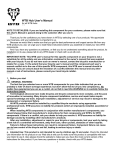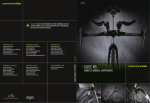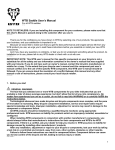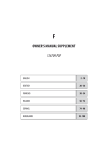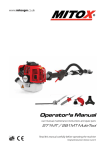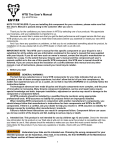Download WTB Rim User's Manual - wtb
Transcript
WTB Rim User’s Manual For all WTB rims. NOTE TO RETAILERS: If you are installing this component for your customer, please make sure that this User’s Manual is passed along to the customer after you use it. GI1-0410 Thank you for the confidence you have shown in WTB by selecting one of our products. We appreciate your business, and your satisfaction is important to us. Because we would like to make sure that you get the best performance and longest service life from any WTB product you use, you MUST read these instructions BEFORE you assemble, install or use your new WTB components. YOUR SAFETY DEPENDS ON THIS. And if you have any questions or problems, or feel you do not understand something about the product, its installation or its use, please talk with your WTB dealer or contact WTB. GI2-0410 IMPORTANT NOTE: This WTB user’s manual for this specific component on your bicycle is not a substitute for all the safety and use information contained in the owner’s manual that was supplied with your bicycle. If you do not have such an owner’s manual, contact the bicycle's manufacturer or retailer for a copy. To the extent that your bicycle user’s manual and this component part user’s manual conflict as to the use of this specific WTB component, this WTB user’s manual should be followed. If you are unsure about the resolution of a conflict between this manual and any other manual or set of instructions, please consult your local bicycle retailer. GI3-0410 READ BEFORE USE: This User’s Manual refers to ESSENTIAL information for: 1(a) 1(b) 1(c) 1(d) 1(e) 1(f) 1(g) Intended Use WTB Rim Summary Chart for Model Year 2010 Rim Size Designation Selecting the Correct Rim Strip Based on WTB Rim Profile Rim/Tire Compatibility under ISO and ETRTO Bike/Brake Compatibility Tire Installation and Removal NOTE: For additional technical information on bicycle wheel rims and tires, see the below manual matrix available at wtb.com/manuals. RIMS TIRES WTB Technical Manuals (Detailed information) A detailed technical explanation of international bicycle rim standards and fundamentals, as applied to WTB Rims, including previous model year products. WTB User Manuals (Less detailed information) Concise user information on WTB Rims. A detailed technical explanation of international bicycle tire standards and fundamentals, as applied to WTB Tires, including previous model year products. Concise user information on WTB Tires. RI1-0410 WTB Rim User’s Manual For all WTB Rims (ver.60910) Page 1 of 15 BEFORE EACH USE CHECK EACH OF THE FOLLOWING: Break wear / operation Always check your disc brake rotors or caliper brake pads for excessive wear before you ride as well as the operation of the brake levers and cables. Spoke tension Before any ride, always check your spoke tension. See Section 3 Maintenance and Repair, below. Rim wear / damage / trueness Always check your rims for any wear, dents, gouges and damage and that the wheels are true before you ride. If there is any damage to your rims, replace them BEFORE you ride. Tires Always check your tires for tire bead and tire sidewall fraying or damage. If either is damaged, see WARNING at Section 3(a). 1. Before you start GENERAL WARNING: The fact that you selected one or more WTB components for your bike indicates that you are probably a rider of above average experience; but do not allow that to lull you into complacency. No matter how experienced you are as a cyclist, do not fail to read this WARNING or to carefully follow the instructions below. Technological advances have made bicycles and bicycle components more complex, and the pace of innovation is increasing. Many bicycle component installation, service and repair tasks require special knowledge and tools. Improper installation, adjustment or service may result in damage to the component or component failure. All WTB products should be installed by a qualified bicycle mechanic using appropriate professional tools. WTB assumes no liability for products which are improperly installed, assembled or configured. When installing WTB components in conjunction with another manufacturer’s components, you should always follow that manufacturer’s instructions for their components and WTB’s for WTB components. If there is a conflict, ask your dealer to help you resolve it. WTB assumes no liability for damage caused by installing other manufacturers’ products. After any installation, adjustment or repair to your bicycle or components, test your work by taking a test ride in a controlled environment, away from cars, other cyclists, obstacles or other hazards. Failure to follow these instructions can result in component failure. Component failure can cause you to lose control of the bicycle and fall, leading to serious injury or death. WTB cannot warn of all potential hazards resulting from misuse of its products, only those that it can reasonably foresee from anticipated use of the product as learned from years of dealing with product issues and consumer questions. GW1-0410 1(a) Intended Use: This product is not intended for use by children age 12 and under. Check the Intended Use information for this product at wtb.com/manuals to make sure this product is compatible with how you intend to use it. Also please check our website to make sure you have the most current version of the instructions for this product. If you have any questions or doubts, check with your WTB dealer or contact WTB. Understand your bike and its intended use. Choosing the wrong component for your intended purpose can be hazardous. Also read, in its entirety, the first WARNING of the Maintenance and Repair section of these instructions. IU1-0410 Determine the Intended Use of your WTB Rim BEFORE you ride it. WTB Rim User’s Manual For all WTB Rims (ver.60910) Page 2 of 15 Intended Use as used in this Manual is influenced by several factors: Rim Size Designation. See Section 1(c); Rim / Tire Compatibility. See Section 1(e); Bike / Brake Compatibility. See Section 1(f); ASTM Intended Use Classification. See Section 1(b); and Industry Standard for Intended Use. See Section 1(b). Intended Use is not the same as “Rim Size.” See also Section 1(c), Rim Size Designation for WTB rim sizes. Information used to determine Intended Use of WTB Rims is contained in the WTB Rim Summary Chart for Model Year 2010 in Section 1(b) below. 1(b) WTB Rim Summary Chart for Model Year 2010 The Common Bicycle Type and Industry Standard Category Name for Intended Use, ASTM Intended Use Classifications, Brake Type, Rim Size Designation, Rim Bead Seat Diameter and Inner Rim Width as set forth by ISO and ETRTO are integrated below for model year 2010 WTB Rims: Bicycle Type WTB Rim Name Mountain 26” SX 24 DX 23 FX 28 Dual Duty XC Dual Duty FR Speed Disc XC Speed Disc All Mountain Speed Disc XL Laser Disc XC Laser Disc Trail Laser Disc FR Laser Disc DH Mountain 650B Laser Disc Trail Mountain 29” Laser Disc Trail 29” Speed Disc All Mountain 29” Dual Duty XC 700C Dual Duty FR 29er Cyclocross 700C SX 24 700C DX 23 700C Dual Duty XC 700C Speed Disc XC 700C Comfort 26” / Cruiser 26” DX 23 Dual Duty XC Hybrid, City, Trekking 700C DX 23 700C Dual Duty XC 700C Rim Bead Seat Diameter Inner Rim Width (in mm) (in mm) WTB Rim Standard Industry Standard Name for Intended Use ASTM Intended Use Classification Brake Type ISO / ETRTO Rim Size Designation ISO/ETRTO ISO/ETRTO ISO/ETRTO GBS GBS GBS GBS GBS GBS GBS GBS GBS Cross Country Cross Country Freeride Cross Country Freeride Cross Country All Mountain Downhill Cross Country All Mountain Freeride Downhill Condition 3 Condition 3 Condition 4 Condition 3 Condition 4 Condition 3 Condition 4 Condition 4 Condition 3 Condition 4 Condition 4 Condition 4 Disc Disc or Caliper Disc Disc or Caliper Disc or Caliper Disc Disc Disc Disc Disc Disc Disc 559 x 17C 559 x 17C 559 x 23C 559 x 19C 559 x 21C 559 x 19C 559 x 21C 559 x 25C 559 x 19C 559 x 21C 559 x 23C 559 x 27C 559 559 559 559 559 559 559 559 559 559 559 559 17 17 23 19 21 19 21 25 19 21 23 27 GBS All Mountain Condition 4 Disc 584 x 21C 584 21 GBS GBS GBS GBS All Mountain All Mountain Cross Country Freeride Condition 4 Condition 4 Condition 3 Condition 4 Disc Disc Disc or Caliper Disc or Caliper 622 x 21C 622 x 21C 622 x 21C 622 x 21C 622 622 622 622 21 21 21 21 ISO/ETRTO ISO/ETRTO GBS GBS Cross Country Cross Country Cross Country Cross Country Condition 3 Condition 3 Condition 3 Condition 3 Disc Disc or Caliper Disc or Caliper Disc 622 x 17C 622 x 17C 622 x 21C 622 x 19C 622 622 622 622 17 17 21 19 ISO/ETRTO GBS Pavement Pavement Condition 1 Condition 1 Disc or Caliper Disc or Caliper 559 x 17C 559 x 21C 559 559 17 21 ISO/ETRTO GBS Pavement Pavement Condition 1 Condition 1 Disc or Caliper Disc or Caliper 622 x 17C 622 x 21C 622 622 17 21 For previous model year WTB rims see WTB Rim Technical Manual. WTB Rim User’s Manual For all WTB Rims (ver.60910) Page 3 of 15 Where possible, in addition to industry standard descriptions, this WTB Rim User Manual references American Society for Testing and Materials (“ASTM”) Standard Classifications for Bicycle Usage to describe Intended Use, along with Common Terms. See ASTM Designation F 2043-09 at www.astm.org For clarification, WTB defines the following terms: Cross Country. ASTM Condition 3. Cross Country riding is focused as much on climbing as it is descending. This style of riding does not include technical terrain and/or jumps. Cross Country bikes are hard tails or short-travel full suspension and set up as minimal as possible to save weight. Riders do not wear protective gear (only helmets). Trail. ASTM Condition 4. Trail (also known as All Mountain) is the most often used term in mountain biking. Trail riding encompasses any and all conditions in mountain biking. Trail bikes are generally full suspension bikes with 4- to 6-inches of travel and they’re built to handle Cross Country climbs, technical terrain and jumps. Freeride. ASTM Condition 4. Freeride is a style of mountain biking that involves excessive speed, big jumps and technical terrain. Riders in this category are most concerned with performing tricks on natural and man-made obstacles. Freeride bikes are generally full suspension bikes with 6- to 8-inches of travel. Downhill. ASTM Condition 4. Downhill is often associated with racing and involves terrain-specific bikes on bike-specific trails. This category is most commonly found at lift-access bike parks that feature big jumps, excessive speed and technical terrain. Downhill bikes are full suspension bikes with 7- to 10inches of travel and built for descending without concern for climbing. Riders wear protective gear (full face helmets and pads). Pavement. ASTM Condition 1. The pavement category can be called comfort, hybrid, city or trekking. This riding includes smooth or paved surfaces, on city streets as well as designated bike paths. Pavement riding does not include jumps of any kind, technical terrain or excessive speed. MTB/ATB. ASTM Condition 2. The MTB/ATB category involves non-technical terrain and moderate speeds on unpaved surfaces and gravel roads. This riding is often performed on entry-level mountain bikes or cyclocross bikes outfitted with offroad-capable tires. If you would like to read a summary of the ASTM F2043 - 09 Standard Classification for Bicycle Usage please visit this link http://www.astm.org/Standards/F2043.htm You will need to purchase the complete standard from ASTM. 1(c) WTB Rim Size Designation Rims, like tires, have a convoluted evolution and often rim “sizes” are referred to inaccurately. Rims are often categorized according to tire “sizes,” which often lack accurate pertinent information to determine tire and rim fit or for Rim Size Designation. To identify Rim Size, WTB follows ETRTO (European Tire and Rim Technical Organization, www.etrto.org) and ISO (International Standards Organization, www.iso.org) definitions and standards, including “Rim Size Designation.” Mountain 26” bikes use 559mm bead seat diameter rims, which are often referred to as 26” or “Mountain Bike” rims. The 26” refers to a traditional measurement based on the outside diameter of a historical tire inflated on an undefined matching rim. DO NOT USE THE 26” REFERENCE TO DETERMINE THE RIM SIZE DESIGNATION. ALSO DO NOT USE THE 26” REFERENCE FOR TIRE SIZE DESIGNATION OR RIM /TIRE COMPATABILITY. WTB Rim User’s Manual For all WTB Rims (ver.60910) Page 4 of 15 The (1) Rim Bead Seat Diameter and (2) Inner Rim Width are the two measurements that define Rim Size or Rim Size Designation. Both numbers are necessary to determine correct rim and tire compatibility. They are measured as shown below. 1(c)(1) Rim Bead Seat Diameter ISO/ETRTO set forth the measuring convention for rim diameter or Rim Bead Seat Diameter. In ISO/ETRTO, rims are grouped by their Bead Seat Diameter measurement. Rim Bead Seat Diameter is measured at the diameter line where the tire bead sits on the Inner Rim Profile. It is very difficult to accurately measure the Rim Bead Seat Diameter pursuant to ISO/ETRTO. Special tools are required. Measurement methods are outlined in ISO and ETRTO. The information in the Summary Chart in Section 1(b) Intended Use above, can help you determine the Rim Bead Seat Diameter of WTB Rims. WTB produces rims with three different Rim Bead Seat Diameters: ISO/ETRTO Rim Bead Seat Diameter 1. 559 mm Common Use Mountain bike Comfort bike Cruiser Bike Common Reference Term 26” 2. 584 mm Mountain bike 650B 3. 622 mm Includes road, trekking, hybrid and city bikes 700C 29” Mountain Bike 29”, 29er Cyclocross Cyclocross 1(c)(2) Inner Rim Width The “Inner Rim Width” Size is shown below as measurement “A,” the width between the two Rim Sidewall Crochet “hooks.” The Rim Sidewall Crochets are the “hooks” on the inside of the rim sidewall. All WTB Rims are Crochet type rims as defined by ISO and ETRTO. All WTB Rims can be measured in the location shown in the diagram below to determine the ISO and ETRTO Inner Rim Width, sometimes referred to as the “A” dimension in ISO and ETRTO. 1(c)(3) Rim Size Designation Once you know the ISO/ETRTO Rim Bead Seat Diameter and Inner Rim Width of your WTB Rim you have the key measurements to determine the Rim Size Designation: The first number in the ISO/ETRTO form is the Rim Diameter. The second number, after “x” is the Inner Rim Width. FOR EXAMPLE: A rim with a Rim Size Designation of 559 x 19C is a rim with a 559 Rim Bead Seat Diameter and a 19mm Inner Rim Width. The “C” designates that the rim is a Crochet type rim. RIM SIZE DESIGNATION IS CRITICAL FOR DETERMINING RIM/TIRE COMPATIBILITY. Additionally, Rim Size Designation can be instructive for Intended Use. For Intended Use see Section 1(b), WTB Rim Summary Chart for Model Year 2010. WTB Rim User’s Manual For all WTB Rims (ver.60910) Page 5 of 15 WTB Rim User’s Manual For all WTB Rims (ver.60910) Page 6 of 15 1(c)(4) Finding the WTB Rim Size Designation with the WTB Rim Sticker (a) Model Year 2010 WTB Rim Stickers identify each WTB Rim’s Bead Seat Diameter, Inner Rim Width and Rim Size Designation: ISO/ETRTO “Rim Size Designation:” Crochet Type Rim 559 x 19C Example: LaserDisc Cross Country Rim Sticker Rim Bead Seat Diameter: 559mm Inner Rim Width: 19 mm * Intended Use Indicator : “Cross Country” The rim is made from aluminum * See also Section 1(b) WTB Rim Summary Chart for Model Year 2010. Tire sizes by Tire Section Width recommended by ISO/ETRTO for use with rims of this Inner Rim Width (and matching diameter). (ISO/ETRTO designate recommended tire sizes by “Tire Section Width” (and matching diameter).) On the WTB Laserdisc Cross Country rim sticker shown above, the Rim Bead Seat Diameter is 559mm and the Inner Rim Width is 19mm, meaning this is a “26” Mountain Bike Rim” with a 19mm Inner Rim Width and a 559mm Bead Seat Diameter. The Rim Size Designation is 559 x 19C. RI2-0410 1(d) Selecting the Correct Rim Strip Based on WTB Rim Profile Use only the correct size rim strip or tape width, thickness and material on WTB Rims. The rim strip or tape must be chosen to guarantee the complete covering of all spoke holes and spoke heads during use, not slip from side to side in the rim or slip around the rim’s diameter, and permit proper mounting, fit and seating of the tire and tube. Dirt, moisture and tire mounting technique can contribute to the slippage or movement of some types of rim tape. Failure to use the correct width rim strip or tape on your WTB wheel, or improper installation of any rim strip or tape can result in improper seating of the tire bead in the rim, which may lead to the tire coming off the rim while riding and or to sudden tire deflation while riding. Failure to make sure that the rim strip or tape covers all spoke holes completely and that it stays in place during use may also lead to the tire coming off the rim while riding and or sudden tire deflation. Sudden tire deflation (or tire coming off while riding) can cause loss of control, resulting in serious injury or death. If you have any questions about the correct size, material or fitting of the rim strip or rim tape, check with your WTB dealer or contact WTB. RS1-0410 WTB Rim User’s Manual For all WTB Rims (ver.60910) Page 7 of 15 1(d)(1) Determine the Inner Rim Profile of your WTB Rim: ISO/ETRTO or GBS This is important for both ease of TIRE MOUNTING and for CHOOSING THE CORRECT RIM TAPE OR RIM STRIP. (i) Confirm whether your WTB rim is “ISO/ETRTO” or “GBS” WTB uses two different Inner Rim Profiles: ISO/ETRTO Profiles follow the International Standards Organization (“ISO”) and the European Tyre and Rim Technical Organisation (“ETRTO”) standards for rim profiles. See www.iso.org, www.etrto.org. Global Bead System™ (“GBS”) profiles follow ETRTO tubeless standards but for tube type application. GBS rims have a Bead Shelf and a GBS Bead Bump to help secure tires to the rim. ISO/ETRTO Rim ( Rim Cross Section Profile Drawing ) Global Bead System (“GBS”) Rim ( Rim Cross Section Profile Drawing ) Bead Shelf = Tire Bead Seat Measuring Point Tire Bead Seat Diameter Measuring Point ISO/ETRTO Rim ( Rim Cross Section Profile Actual Picture) Tire Bead Seat Diameter Measuring Point Bead Bump “GBS Bump” Global Bead System™ (“GBS”) Rim ( Rim Cross Section Profile Actual Picture Bead Shelf = Tire )Bead Seat Measuring Point Bead Bump “GBS Bump” ISO/ETRTO Rims are designed using ISO and ETRTO Standards Global Bead System (“GBS”) Rims use ISO and ETRTO and Tubeless ETRTO Standards GBS is designed with a “Bead Shelf,” similar to what is used on rims for motorcycles and cars, and is similar to ETRTO tubeless rim profile standards for bicycles. The Bead Shelf gives the tire bead a secure engagement point around the entire circumference of the Tire Bead Seat of the rim. RI3-0410 TIRE MOUNTING: Tires may be harder to install on GBS Rims than on ISO/ETRTO Rims (See also: WTB Tire User Manual: Tire Installation & Removal). GBS Rims need the correct rim strip to properly fit a tire. See Section 1(d)(3) Rim Strips or Tape for WTB GBS Rims below. If you are having a difficult time mounting a tire on a WTB GBS Rim, make sure that you are using the correct Rim Strip. WTB Rim User’s Manual For all WTB Rims (ver.60910) Page 8 of 15 Tires that fit too tightly often irritate riders. Tire levers should not be used to mount tires. Also in some cases users can damage the bead of the tire (or the tube) in attempting to mount a “tight” tire. If your tire goes on and off your rim with little hand mounting effort do not ride it. That is the sign of a possible mismatch between that particular rim and tire. If you have another brand or model of rim that is compatible with that tire’s size designation, try mounting the tire on that rim to see if it is looser or tighter. If sufficiently tight then use that rim and tire together or contact WTB for assistance. A tire that fits too loose can come off the rim while riding (causing serious injuries or death) especially at air pressure approaching or below the minimum posted on the tire or under hard riding and cornering conditions. TI1-0410 You can determine whether your WTB Rim is ISO/ETRTO or GBS by looking at the information below, by checking the Summary Chart in Section 1(b) or by checking the Inner Rim Profile for the GBS Bump. If there is a flat Bead Shelf, or GBS Bump, the rim is a GBS Rim. If there is no flat Bead Shelf or no GBS Bump, then it is an ISO/ETRTO Rim. 1(d)(2) Model Year 2010 WTB Rims by ISO/ETRTO or GBS Inner Rim Profile i. WTB Rims with ISO/ETRTO Inner Rim Profile The following model WTB Rims have the ISO/ETRTO Inner Rim Profile: SX 24 DX 23 FX 28 SX 24 700C DX 23 700C ii. WTB Rims with GBS Inner Rim Profile The following model WTB Rims have the GBS Inner Rim Profile: Dual Duty, including: Dual Duty Cross Country Dual Duty Freeride Dual Duty Cross Country 700C Dual Duty Freeride 29” Speed Disc, including: Speed Disc Cross Country Speed Disc All Mountain Speed Disc XL Speed Disc All Mountain 29” Speed Disc Cross Country 700C Laser Disc, including: Laser Disc Cross Country Laser Disc Freeride Laser Disc Downhill Laser Disc Trail Laser Disc Trail 29” RI4-0410 WTB Rim User’s Manual For all WTB Rims (ver.60910) Page 9 of 15 1(d)(3) Rim Strips or Tape for WTB GBS Rims WTB recommends you do not use a rim strip that covers ANY PART of the Bead Shelf of any WTB GBS Rim. Putting rim tape or rim strips under the tire bead above the rim bead seat may cause the bead to seat incorrectly and may result in sudden tire deflation, which can cause you to lose control and fall. See also Selecting the Correct Rim Strip Based on WTB Rim Profile. WTB GBS Rims are designed to work with WTB rim strips, which can be purchased from a WTB dealer or by a dealer from WTB. ALL grey WTB Rim Strips are 11mm wide and specially designed to fit WTB GBS Rims and to keep the spoke holes covered during riding. If you cannot obtain a WTB Rim Strip, we recommend that you use rim tape of the proper 11mm width and that you do not put the rim tape where it can work its way under the bead of the tire, especially if it is a WTB GBS Rim. As well, the rim strip or tape must be chosen to guarantee the complete covering of all spoke holes and spoke heads during use, not slip from side to side in the rim or slip around the rim’s diameter, and permit proper mounting, fit and seating of the tire and tube. Dirt, moisture and tire mounting technique can contribute to the slippage or movement of some types of rim tape. RS2-0410 Neither WTB ISO/ETRTO profile Rims nor WTB GBS Rims are designed to work with tubeless systems, including with conversion kits with sealants, or otherwise. DO NOT use any WTB GBS Rims with tubeless tires, either with sealants OR any other add-on that requires putting rim tape or rim strips between the tire bead and the rim bead seat. Doing so may cause the bead to seat incorrectly, which could result in the tire coming off the rim while riding and or sudden tire deflation, which can cause you to lose control and fall. See also Selecting the Correct Rim Strip Based on WTB Rim Profile. 1(e) Rim / Tire Compatibility under ISO and ETRTO Both ISO and ETRTO have recommendations for rim and tire compatibility. ETRTO has “Approved Rim Contours” for compatibility with specific Tire Section Widths. ISO has “Recommended Rims” for specific Tire Section Widths (referred to in ISO as “Nominal Section Width”). For Rim / Tire compatibility information please see the WTB Rim / Tire Compatibility Manual and the WTB Rim Technical Manual at wtb.com/manuals. Failure to confirm tire/rim compatibility, properly install, operate and maintain any component or accessory can result in serious injury or death. CO1-0410 WTB Rim User’s Manual For all WTB Rims (ver.60910) Page 10 of 15 WTB rims and tires are designed to fit together within the ISO/ETRTO recommendations. If you choose to use non-WTB branded tires on WTB rims or vice versa WTB cannot guarantee that they will fit as optimally as WTB branded tires and rims. In some cases the misfit between a non-WTB and WTB product could result in a sudden loss of air pressure and or a tire coming off a rim during riding resulting in serious injury or death. CO2-0410 Tires and Rims should be compatible, because they should be made to the same basic international standards; but WTB cannot guarantee that all manufacturers make their products in compliance with international standards. While everyone in the bicycle industry tries to work to industry accepted standards, there is no guarantee of 100% inter-brand compatibility of components. All manufacturers recommend that you do not “mix and match” brands of components, so if you do, you are on your own. CO3-0410 If your tire goes on and off your rim with little hand mounting effort do not ride it. That is the sign of a possible mismatch between that particular rim and tire. If you have another brand or model of rim that is compatible with that tire’s size designation, try mounting the tire on that rim to see if it is looser or tighter. If sufficiently tight then use that rim and tire together or contact WTB for assistance. A tire that fits too loose can come off the rim while riding (causing serious injuries or death) especially at air pressure approaching or below the minimum posted on the tire or under hard riding and cornering conditions. CO4-0410 1(f) Bike/Brake Compatibility WTB sells different rims for disc brake and caliper brake (sometimes referred to as “rim brake”) applications, and the two are not interchangeable. Check the WTB Rim Summary Chart for Model Year 2010 in Section 1(b) above to make sure your WTB Rim is compatible with your Intended Use. If you have any questions or doubts, check with your WTB dealer or contact WTB. Disc Brakes consist of a metal disc attached to the wheel hub that rotates with the wheel. Calipers are attached to the frame or fork along with pads that squeeze together on the DISC. Caliper Brakes consist of a pair of brake arms that carry brake pads which move inwards and press on the RIM of the wheel. WTB Rim User’s Manual For all WTB Rims (ver.60910) Page 11 of 15 WTB SpeedDisc and LaserDisc rims are DISC BRAKE SPECIFIC. They should be used with ONLY disc brake braking systems. WTB’s “Dual Duty” rims are intended for Disc or Caliper brake braking systems. The warnings are different for Disc Brake and Caliper Brake rims. Read the warning label on your WTB rim and always follow the directions. (1) Disc Brake Warning Sticker Warning: DISC BRAKE ONLY Explanation: Only use these rims with disc brakes. DO NOT use these rims with caliper brakes. WTB rims designed for use with disc brakes have a “Disc Brake Only” warning label (above) and a convex shape on the rim’s sidewall that does not work properly with caliper brakes. Some high end WTB disc brake rims have a raised “crescent moon” of extra material on the outside of the rim, which would make caliper brake application more dangerous. This adds material to the exterior of a caliper braking surface. WTB refers to this feature as “Unbendium Bulge™.” This is a proprietary WTB Rim feature. The Unbendium Bulge feature is found on MY2010 LaserDisc Rims. Drawing of Rim Profile Cross Section with Unbendium Bulge Actual Photo of Rim Profile Cross Section with Unbendium Bulge Unbendium Bulge (2) Caliper Brake Warning Sticker The Caliper Brake Warning Label does not have the “Disc Brake Only” warning. Rims with a Caliper Brake Warning Label can be used with either caliper or disc brakes. WTB Caliper Brake Rims have a flat sidewall for brake pad engagement. There is also a groove in the sidewall braking surface that, when it begins to disappear or wears off at any point, shows that the rim needs to be replaced due to sidewall wear from the use of caliper brakes. RI5-0410 WTB Rim User’s Manual For all WTB Rims (ver.60910) Page 12 of 15 The sidewalls of WTB caliper brake rims are made out of materials that wear through the abrasive action of brake pads will have a limited lifetime. The lifetime of the bicycle rim will depend on the material of the brake pads and the use of the bicycle. As a result of excessive wear, the bicycle rim sidewall may collapse as it will not be capable of maintaining the tire pressure, causing instant deflation. To maintain safety and provide correct fitting of the tire, the user of such rims and brakes must be notified of the state of wear of the rims, allowing replacement of the rim when required. The sidewalls of WTB caliper brake rims starting in Model Year 2003 should have an indicator line in the sidewall of the rim that shows when the rim must be replaced. See Section 3: Maintenance and Repair, below. For rims without indicator lines, WTB recommends immediate replacement of the rim with a new rim with an indicator line unless you can make a caliper measurement of the rim sidewall thickness and contact WTB for information about the proper thickness. ETRTO-0410 1(g) Tire Installation and Removal. See WTB Tire User Manual at wtb.com/manuals. 2. Wheel Assembly Building a bicycle wheel or replacing a damaged rim requires a great deal of skill and experience, as well as special tools and special knowledge. Do not entrust your WTB rim to anyone but the most skilled and experienced wheel builder in your area. RI6-0410 3. Maintenance and Repair Many bicycle component installation, service and repair tasks require special knowledge and tools. Do not begin any installation, adjustments or service on your bicycle until you have learned from your dealer how to properly complete it. Improper installation, configuration, adjustment or service may result in damage to the component or component failure. Component failure can cause you to lose control and fall. BPSA-OM9-5 Like any mechanical device, a bicycle and its components are subject to wear and stress. Different materials and mechanisms wear or fatigue from stress at different rates and have different life cycles. If a component’s life cycle is exceeded, the component can suddenly and catastrophically fail, causing serious injury or death to the rider. Creaks, scratches, cracks, fraying and discoloration are signs of stress-caused fatigue and indicate that a part is at the end of its useful life and needs to be replaced. While the materials and workmanship of your bicycle or of individual components may be covered by a warranty for a specified period of time by the manufacturer, this is no guarantee that the product will last the term of the warranty. Product life is often related to the kind of riding you do and to the treatment to which you submit the bicycle and its components. The warranty is not meant to suggest that the bicycle or a component cannot be broken or will last forever. It only means that the bicycle or component is covered subject to the terms of the warranty. BPSA-OM9-5A The “useful life” of this component (the time during which the component is safe to ride) will be reduced if (1) you use it more than the average user; (2) you are heavier than the average rider; (3) the terrain/roads you ride on is rougher than average; (4) you tend to be harder on components than the average rider; (5) you fail to follow its installation instructions or maintenance instructions, including lubrication and adjustment; (6) it must endure more adverse environmental conditions than the average component (i.e. sweat, corrosive mud, salty beach air etc.); (7) you damage/weaken it in a crash, jump or through other abuse; (8) you fail to purchase the appropriate model of product for the type of riding it endures; and/or (9) you race with the component or participate in any other type of extreme, aggressive riding such as Aggro, Hucking, Freeride, North Shore, Downhill, Jumping, Stunt Riding, etc. The more factors you meet and the more often they occur, the more this component’s life will be reduced, however it is impossible to say how much. Racing places extreme stress on bicycles and their components (like it does riders) and significantly shortens their usable or “useful” life (the time during which the component is safe to ride). If you participate in these types of events, the lifetime of the product may be significantly shortened depending upon the level and amount of racing. The “normal wear” of a component may differ greatly between competitive and non-competitive uses, which is why professional level riders WTB Rim User’s Manual For all WTB Rims (ver.60910) Page 13 of 15 often use new bikes and components each season as well as having their bikes serviced by professional mechanics after each ride. Particular care should be placed in the regular examination of your bicycle and its components to ensure your safety. UL2-0508-1 If you engage in extreme, aggressive stunt or competition riding, you will get hurt, and you voluntarily assume a greatly increased risk of injury or death. Not all bicycles, components or equipment are designed for these types of riding, and those that are may not be suitable for all types of aggressive riding. Check with the bicycle’s or component’s manufacturer about suitability before engaging in extreme riding. When riding fast down hill, you can reach speeds achieved by motorcycles, and therefore face similar hazards and risks. Have your bicycle and equipment carefully inspected by a qualified mechanic and be sure it is in perfect condition. Consult with expert riders, area site personnel and race officials on conditions and equipment advisable at the site where you plan to ride. Wear appropriate safety gear, including an approved full face helmet, full finger gloves, and body armor. Ultimately, it is your responsibility to have proper equipment and to be familiar with course conditions. Although many catalogs, advertisements and articles about bicycling depict riders engaged in extreme riding, this activity is extremely dangerous, increases your risk of injury or death, and increases the severity of any injury. Remember that the action depicted is being performed by professionals with many years of training and experience. Know your limits and always wear a helmet and other appropriate safety gear. Even with state-of-the-art protective safety gear, you could be seriously injured or killed when jumping, stunt riding, riding downhill at speed or in competition. BPSA-OM9-2F Over time, rims experience stresses and, depending on make, use, condition, proximity to salt water, and other material and product stresses, rims wear out and need to be replaced. Rims and wheels should ALWAYS be checked before EVERY ride for wear, damage and trueness. Further, you should consider replacing any rims over five (5) years old with more current designs. If tough terrains and tire flats are a concern, the Global Bead System provides a more secure tire/ rim fit. If you are not on current WTB ISO/ETRTO Rims or WTB Global Bead System Rims, we recommend that you upgrade. RI7-0410 3(a) Maintenance Keep wheel rims clean and free of grit, dirt and oil or grease. Never use strong abrasive materials or chemicals to clean your rims, as they can damage rim or tire surfaces and weaken the rim sides or tire and tube integrity. Do not use water under high pressure to blast off dirt and mud. The water could penetrate the seals and damage the bearings and other metal parts. Periodically lubricate the threads and cam surfaces on the quick release skewer or the threads on the axle bolts of the Single Duty hub. Before each use, check brake wear and operation; spoke tension, rim wear, damage and trueness; and tire fit, wear, damage and inflation. Spin each wheel slowly and look for any signs of damage: dents, bulges, cracks, or deformation of the rims. If you do not have a spoke tensiometer, check spoke tension, by spinning the wheel to make sure it is true (no side-to-side wobble, no up-anddown hop); by squeezing pairs of spokes to make sure none are loose or broken; and by plucking each spoke to make sure they all sound about the same. If you discern a difference in tension when squeezing two adjoining spokes or in the pitch of the sound of a plucked spoke this may indicate a significant difference in that spoke’s tension. If in doubt about spoke tension or wheel trueness, do not ride the bike. Take it to a qualified bicycle mechanic. With rim brakes, check that the wear indicator on the sidewall braking surface is still clearly visible. Before every ride, check the tires for excess wear, cuts in the tread and cuts or bulges in the sidewall. Check the tire pressure of both tires. The tire’s pressure rating is marked on the sidewall. WTB Rim User’s Manual For all WTB Rims (ver.60910) Page 14 of 15 Spoke tensioning and wheel truing (with or without spoke replacement) is a highly refined skill which requires expensive special tools and experience. Do not attempt to tension or true a wheel unless you have the knowledge, experience and tools needed to do the job correctly. WH2-0410 Do not ride a bike with a damaged tire or rim. Cuts or wear to critical portions of the tire bead or sidewall and dents, cracks or scrapes to critical portions of the rim may appear minor but can reflect more major latent damage to the rim or tire and could result in or be a warning sign of impending catastrophic failure. Riding a damaged tire or rim may lead to sudden tire deflation or improper braking function. Sudden tire deflation or improper braking function can cause loss of control, resulting in serious injury or death. Replace damaged tires and rims before riding the bike. Never inflate a tire beyond the maximum pressure, or ride a tire with less than the minimum pressure marked on the tire’s sidewall. Exceeding the recommended maximum or minimum pressure may cause sudden tire failure. Tire failure can cause loss of control, resulting in serious injury or death. TI2-0410 3(b) Service and Repair We strongly urge you to have any servicing or repair of your WTB components done by a qualified bicycle mechanic with the appropriate tools, knowledge and experience. If you believe that you are qualified to service, replace parts or repair a WTB component, please download, read and follow the Service Instructions at wtb.com/manuals for the component which you plan to repair. SE1-0410 Wheel truing and spoke tension adjustment require special skills and tools. Do not attempt to tension or true a wheel. Take the wheel to a qualified bicycle mechanic before riding. Wheel rims with dents, bulges, cracks, or deformation are unsafe to ride and cannot be repaired. They must be replaced. Rim replacement requires special skills and tools. Do not attempt to replace a wheel rim. Take the wheel to a qualified bicycle mechanic before riding. RI6-0410 4. Replacement Parts Use only genuine WTB replacement parts and follow the Service Instructions at wtb.com/manuals. Failure to do so could compromise the safety or performance of the component and result in component failure. GI4-0410 5. Warranty WTB products are warranted against defects in materials and workmanship. To read the full current warranty for your WTB product, see the Warranty section of our Web site, wtb.com/warranty GI5-0410 6. Making a warranty claim To make a warranty claim, see the Warranty section of our Web site, wtb.com/warranty GI6-0508-1 7. Contact Information If you have any questions or problems with any WTB product, please go to wtb.com for help. GI7-0508-1 8. Disclaimer The original English language version/meaning of these instructions supercedes all translations. WTB is not responsible for any errors in translation of these or any product instructions. GI8-0508-1 © Copyright WTB June 2010 WTB Rim User’s Manual For all WTB Rims (ver.60910) Page 15 of 15



















